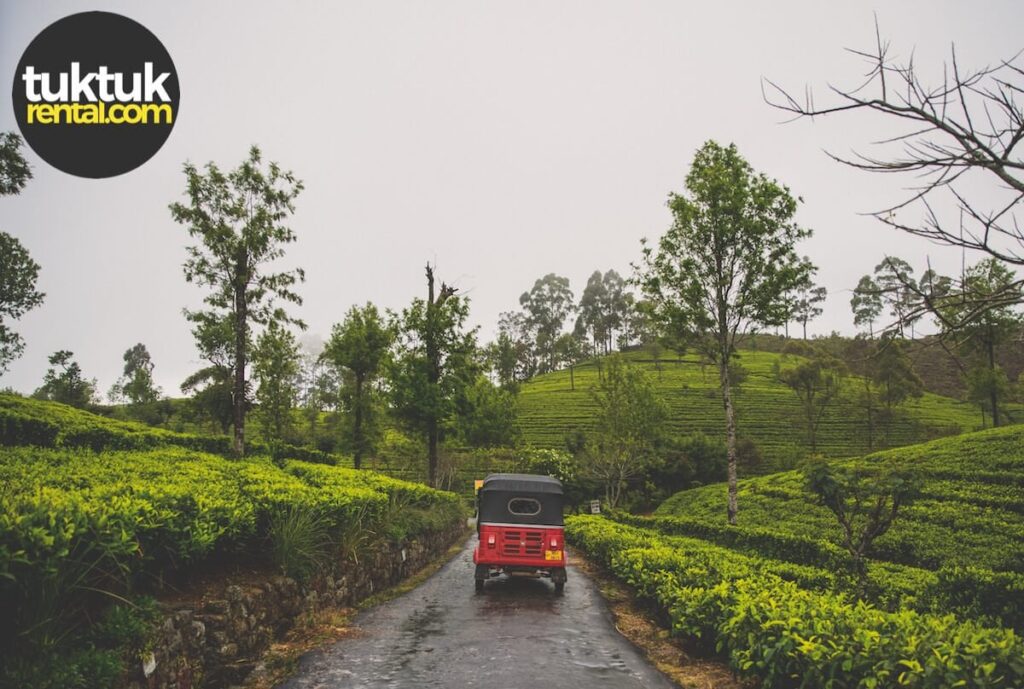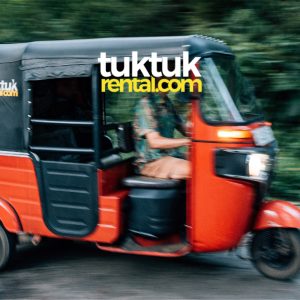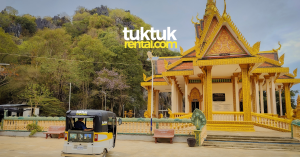If you’ve ever pictured yourself cruising through Sri Lanka’s lush landscapes, vibrant towns, and serene coastal roads in your own tuktuk, you’ve probably asked: Is it safe to drive a tuktuk in Sri Lanka? At tuktukrental.com, we’re a social business that helps support local tuktuk owners by providing them extra income. We’ve pioneered the self-drive tuktuk concept since 2016. Good news: with proper preparation, licensing, and support, driving a tuktuk can be both safe and legal. Bad news: driving a vehicle in any country (including your own) is a risk, Sri Lanka is no different and has some unique traffic conditions.
Road Safety in Context
Sri Lanka’s roads are a mix of motor cars, dual-purpose vehicles (like vans and pickups), motorcycles, buses, and tuktuks (three-wheelers). Road safety initiatives have paid off: fatalities decreased from 3,097 in 2019 to 2,515 in 2022. (Source: Ministry of Transport).
As of December 2022, Sri Lanka had over 8.35 million registered vehicles, including roughly 1.18 million three-wheelers and 901,869 cars. (Source: Department of Motor Traffic, Table 7.2). Tuktuks are integral to the country’s transportation ecosystem.
World Bank Report: Road Safety in Sri Lanka
Tuktuks typically travel at around 40 km/h and offer excellent visibility—factors that help reduce the severity of accidents. Research, including the World Bank’s “Delivering Road Safety in Sri Lanka” report (Source), shows that:
- 70% of crashes involve low-income commuters and motorcycles.
- Pedestrians make up almost 33% of road fatalities.
- Speed, drink driving, fatigue, burst tyres and animal crossing are the main causes for crashes.
- Three-wheelers (tuktuks) are don’t dominate the fatal crash statistics, especially considering the distance travelled.
Comparing Tuktuks to Other Vehicle Types
There are risks associated with driving on roads in any country; Sri Lanka is no different. According to the National Council for Road Safety, 2022 statistics in terms of deaths in road accidents in Sri Lanka, driving a tuktuk has a similar fatality chance as driving a car. The statistics demonstrate motorcycles have the highest fatality rating, at 39.9%, followed by lorries at 14.1%, three-wheelers at 12.5%, dual-purpose vehicles at 11.9%, motor cars at 10%, private buses at 7.6%, SLTB buses at 2.8% and cycles at 1.3%.
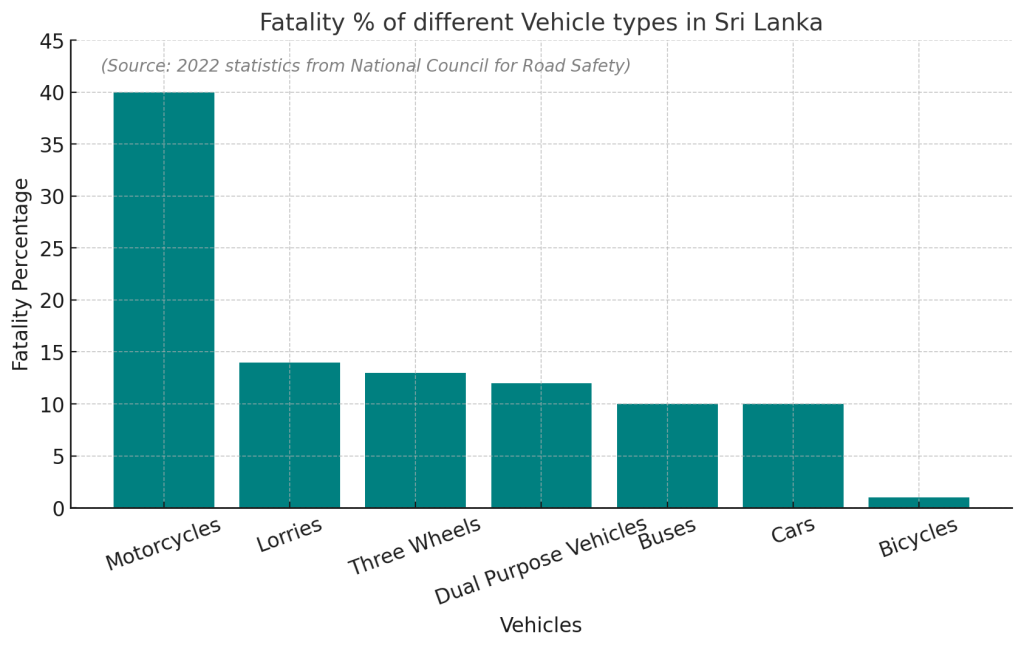
The speed limit placed on tuktuks is 40km/hr, so, in most cases, where there is an accident, there is minor vehicle damage. As per tuktukrental.com record keeping, 0.001% of customers are involved in incidents where a person (either the customer or 3rd party) is admitted to the hospital.
Further statistics recorded by the department show the number of persons killed in road accidents. In 2022, these statistics indicate that motorcycles are the highest risk, accounting for 33.2%, followed by pedestrians at 31.2%, passengers at 12.4%, bicyclists at 8.9%, drivers at 7.5%, rear riders at 7.5% and others at 0.2%. If we take pedestrians and motorcyclists (and their riders) combined, they account for 61.9% of the total.
Read more about: Is It Safe to Travel in a Tuktuk in Sri Lanka?
Here is the link to the Sri Lankan government website with these statistics.
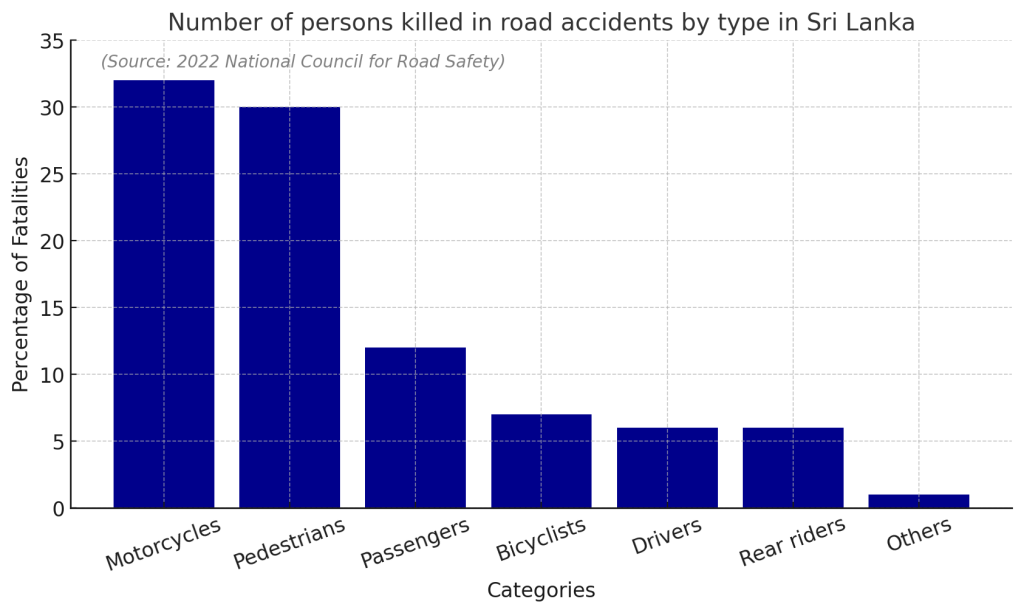
Combined 2022 Accident Data (Source: Sri Lanka Ministry of Transport):
| Vehicle Type | Fatal | Minor | Critical | Damage Only | Total Accidents | % of Total (All 4) | % of Total Fatal |
|---|---|---|---|---|---|---|---|
| Motorcycles | 908 | 3188 | 2541 | 643 | 7280 | 42.81% | 53.70% |
| Tuktuks (3-Wheelers) | 285 | 1584 | 929 | 717 | 3515 | 20.67% | 16.85% |
| Dual Purpose (DP) | 271 | 918 | 704 | 899 | 2792 | 16.42% | 16.03% |
| Motor Cars (MC) | 227 | 1058 | 773 | 1361 | 3419 | 20.10% | 13.42% |
Key Takeaways:
- Motorcycles lead in risk: About 43% of total accidents and over half of all fatal accidents involve motorcycles.
- Tuktuks fare better: Tuktuks account for around 21% of total accidents and 17% of fatal ones—less than motorcycles and even less than motor cars plus dual-purpose vehicles combined (29.4% fatal).
- Considering Everyday Transport: In Sri Lanka, many people rely on dual-purpose vehicles (SUVs, vans), similar to how others use cars. Whether we compare tuktuks to motor cars or combine cars with dual-purpose vehicles to reflect everyday usage, tuktuks still emerge as a relatively safer option.
Concerned About Tourists on Scooters?
Scooters are classified as motorcycles in Sri Lanka and require an “A” endorsement on your license. Many tourists ride scooters without proper licensing, which is illegal and riskier, given motorcycles’ higher accident rates. If you’re worried about tourist safety, be more concerned about unendorsed scooter riders than those navigating a tuktuk legally and slowly.
Insurance: Your Safety Cushion
At tuktukrental.com, we provide comprehensive insurance:
- Coverage: Damage to your tuktuk and other vehicles, plus injuries to you, your passengers, or third parties at government hospitals.
Have Your Own Travel Insurance: This ensures access to private healthcare if needed. - Proven Track Record: 98.67% of our customers face no damage-related charges during their trips, reflecting the effectiveness of our preparation and guidelines.
Preparing You for the Road
We do more than just hand over keys:
- Driving Tutorial Video: Our How to Drive a Tuktuk video guides you through the basics.
- In-Depth Briefing: We explain road etiquette, local conditions, and safe driving practices in person before every trip begins.
- 24/7 Emergency Support: Hundreds of mechanics and a dedicated team are on standby. (We strongly recommend NOT DRIVING long-distance at NIGHT)
- Comprehensive Lessons & Advice: If you’re uncomfortable driving, we’ll advise against it.
Legality & Licensing: Driving a Tuktuk as a Tourist
Sri Lanka follows the 1949 Geneva Convention on Road Traffic, which regulates international driving and the Motor Car (Convention) Ordinance, which regulates tourist driving in Sri Lanka. If you have a license with a “B” (car) endorsement through either (a) IDP, or, (b) your regular country license – you can get a license for driving a tuktuk in Sri Lanka.
Crucial Point: Through the FIA (Fédération Internationale de l’Automobile), we’ve confirmed that tuktuks fall under the “B” category, similar to cars. The FIA’s global motoring authority gives this classification credibility.
Steps for Tourists to drive in Sri Lanka:
- Option 1: Obtain a B-Category IDP and get a Sri Lankan driving permit from the Automobile Association of Ceylon.
- Option 2: Present your national/regular in-country license with type “B” endorsement, and get a Sri Lankan driving permit at the Automobile Association of Ceylon.
Practical Safety Tips
- Stick to 40 km/h: Helps minimise risk and maintain control.
- Anticipate Sudden Moves: Pedestrians, animals, and slow farm vehicles may appear unexpectedly.
- Practice in Quiet Areas: Build your confidence before tackling busy roads.
Final Thoughts: Safe, Legal, and Memorable
Is it safe to drive a tuktuk in Sri Lanka? The data, the global confirmations, and our on-the-ground experience say yes. Compared to motorcycles and even the combined category of cars and dual-purpose vehicles, tuktuks fare well in terms of safety. With proper insurance, thorough training, and 24/7 support, you’ll be well-prepared to enjoy a truly unique travel experience.
Embrace the freedom of exploring Sri Lanka at your own pace, confident that you’ve chosen a relatively safer mode of transport—and that we’ve got your back every kilometre of the way.
Safe travels!
